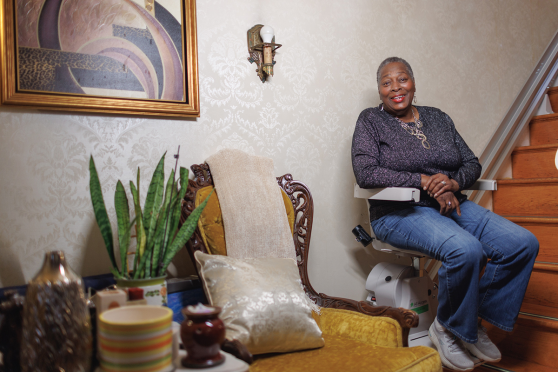Ways to make colonoscopy prep easier
Colonoscopies are often thought of as a total drag, but they are helpful for finding colon cancer early. Follow these expert tips to create a more comfortable experience.

If you’re signed up for a colonoscopy this year, give yourself a pat on the back: Colorectal cancer screenings, when performed regularly, can help find cancer early. And that’s when it’s easier to treat. In other words, they could save your life.
In fact, colorectal cancer is the third-leading cause of cancer-related deaths in men and women in the United States, according to the American Cancer Society. And every year, approximately 1 in 23 American men and 1 in 26 women are diagnosed with it.
You have different options when it comes to screening tests. Talk to your doctor about what test type and frequency is right for you, keeping in mind the colonoscopy remains the gold standard in preventing and diagnosing colorectal cancer.
Despite that reassurance, you might also have some hesitations about the procedure itself. Gastroenterologist Maurice A. Cerulli, M.D., an associate professor at the Zucker School of Medicine at Hofstra/Northwell, and a physician for Northwell Health in Long Island, New York, says that prep for the procedure, which may consist of strong laxatives and fasting, scares away roughly 10 percent of patients.
This shouldn’t be the case for a potentially life-saving procedure. The outcome of completing a colonoscopy is absolutely worth the energy spent preparing for it.
What is a colonoscopy?
The test involves threading a colonoscope, a long, flexible tube with a camera, through the 5-foot length of the large intestine. Your doctor will do all they can to make the procedure quick and painless, including offering you sedation options.
The doctor also provides information on what to expect, including instructions for your test preparation kit. And you’ll get plenty of guidance for getting through the uncomfortable parts in the bathroom that are often unavoidable.
Below are Dr. Cerulli’s top tips for colonoscopy prep:
Tip 1: Check in with your doctor
Several weeks before the screening, inform your doctor about your work schedule, insurance coverage, anesthesia concerns, and usual bowel habits. “For instance, if you tend to be constipated or if you have kidney issues, we can change the preparation formula we use,” says Dr. Cerulli.
Similarly, if you just don’t think you can stomach the usual pre-colonoscopy drinks, ask your doctor about alternative preparations, laxative pills, or even enemas.
Tip 2: Stick to your prep schedule
Pay attention to when your doctor says you need to begin modifying your diet, fasting, and starting your preparation drink. Set reminders on your calendar or your phone to help you remember. Staying on schedule will help make the elimination process that much easier.
Tip 3: Make a list of off-limits foods
Certain foods that are tougher to digest and eliminate should be avoided during colonoscopy prep. These include seeds, nuts, popcorn, fatty foods, tough meat, whole grains, raw veggies, fruits with seeds (such as strawberries) or edible skin (think apples), corn, broccoli, cabbage, beans, and peas.
Tip 4: Indulge before “The Big Prep”
Dr. Cerulli believes that allowing treats immediately before the formal preparation schedule makes it easier to handle what comes next.
“I’m a big fan of ice cream before the prep,” says Dr. Cerulli, who also recommends foods like soft cheeses, milkshakes, and white yogurt. These so-called “solid liquids” are particularly helpful for people who might become ravenously hungry at work before the test day.
Your doctor will tell you when your actual fast will begin. At that point, you’ll stop consuming all solid foods and switch to clear liquids only.
Tip 5: Make the preparation drink palatable
Downing the liquid laxative doesn’t have to be a total chore. Try adding a sweetener to make it easier to drink. “Anything that dissolves into a clear liquid is acceptable, from apple juice to white grape juice to ginger ale, and some people like bouillon to warm up,” says Dr. Cerulli.
Some doctors recommend sticking with artificially sweetened versions of juice rather than sugar, which can make the intestinal lining absorb more water. Always ask your physician what’s right for you.
Other tips: Chill the liquid to cut the saltiness and sip it through a straw on the back of your tongue to avoid having the liquid in your mouth (and on your taste buds) for too long. Dr. Cerulli also recommends switching between sips of the preparation liquid and licks of an ice pop, Jell-O, clear sodas or juices like ginger ale, or flavored water or seltzer.
Just don’t buy anything with a deep red, purple, or blue color that could leave a stain on your colon. The doctor could mistake this for an abnormality.
Tip 6: Ensure your bathroom experience is comfortable
About one to three hours after you’ve downed the first half of your laxative solution, plan to be near a bathroom. This will be roughly 16 hours before your colonoscopy. It may be helpful to keep plenty of wipes, soft toilet paper, and ample handwashing liquid within convenient reach. Also, consider creating a relaxing playlist or queuing up your favorite podcasts to keep you company during extended bathroom visits.
Tip 7: Drink water frequently
Throughout the prep process, and especially once you’ve been using the bathroom, it’s important to keep your digestive system moving with lots of clear liquids.
“Diarrhea removes fluids, so you’ll have to continually replace them with water in addition to the prep liquid to prevent dehydration,” says Dr. Cerulli.
But don’t consume a gallon all at once, he advises. Sip slowly and alternate the prep drink with water flavored with lemon, clear juices, or clear sodas. Aim for 8 ounces every 15 minutes. When the diarrhea is as clear as your liquids, possibly with a slightly yellowish hue, you’re done. Otherwise, amp up the water intake.
Tip 8: Plan for potential irritation
Nonstop bathroom trips can create irritation, so keep aloe wipes handy. “Your loose bowel movements contain lots of bile that can burn your skin, so regular toilet paper is inadequate,” says Dr. Cerulli.
But be careful not to apply any creams until your skin is totally clean and dry. This includes diaper rash ointment. Here’s why: “Creams can trap irritants that aren’t completely removed and make things worse,” says Dr. Cerulli.
Tip 9: Think ahead to post-procedure
Some people emerge from a colonoscopy feeling energized and refreshed, but many patients have some unsteadiness from the sedation. Be sure to arrange for a driver to take you home from the test after you’ve finished; you won’t be allowed to drive yourself if you’ve been sedated.
Beyond that, expect some cramping and discomfort, which is mostly due to the air that is pumped into the colon during the test to make it easier to examine. That means you might be a little gassy, but it should resolve fairly quickly.
Ready to get started? Contact your doctor to schedule your colonoscopy. The sooner you check your colonoscopy off your list, the better off you’ll be.



